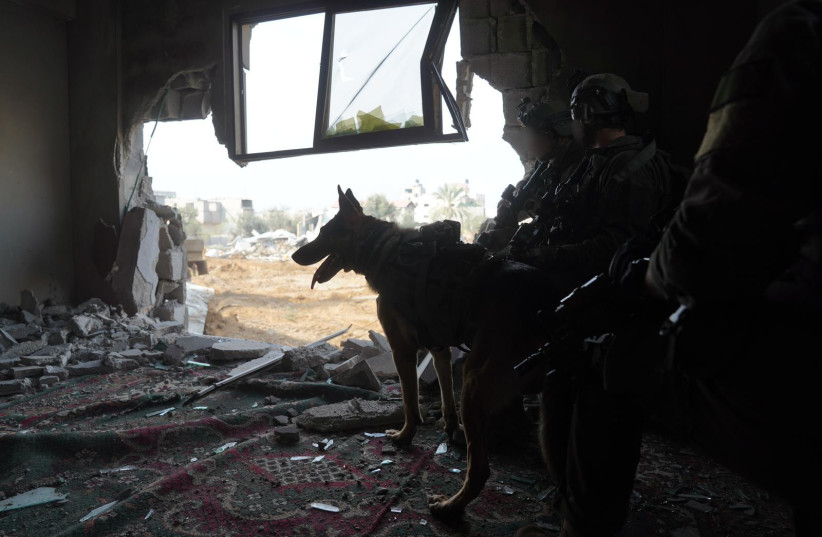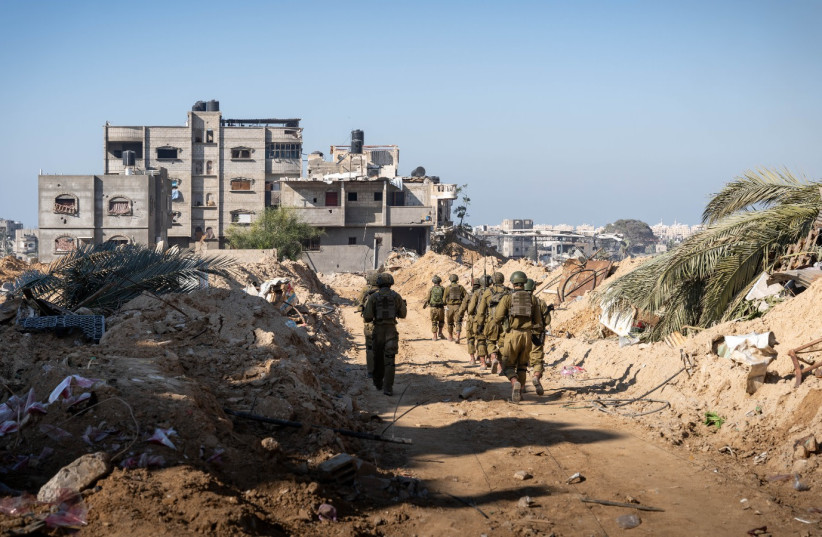A group of journalists entered southern Gaza on Thursday – in that area for the first time – including the remains of one of the homes of Hamas leader in Gaza, Yahya Sinwar.
This visit was likely the closest the media has gotten to Sinwar – and the remaining hostages were taken from Israel on October 7 – given IDF intelligence predictions that he is hiding in the tunnels of Khan Yunis with hostages nearby.
Under constant background shooting and large explosions said to be a mix of air strikes, artillery, or tank attacks, highly armored “Namer vehicles” escorted the journalists on the trip, traveling between an IDF base, the Khan Yunis headquarters of the IDF, Sinwar’s house, and a stop to get supplies. These vehicles are capable of resisting rocket-propelled grenade hits.
An IDF airstrike has turned Sinwar’s house into a crater. Another house across the street (now rubble) saw heavy fighting just two days before, according to IDF sources. Though the house was still standing, it bore signs of explosions and bullet holes throughout.

Two key IDF commanders gave The Jerusalem Post on-and-off-record updates on the status of the all-important front, which will decide the fate of Hamas, the Israeli hostages, and the war in general.
IDF made considerable progress in Khan Yunis, commander says
“This crate is what is left of the house,” said IDF 98th Division Commander Brig.-Gen. Dan Goldfus added that they attacked it from the air.
Goldfus said that the military made considerable progress against Hamas in three weeks of fighting in Khan Yunis.
He said the IDF’s artillery and air force undertook 1,300 attacks in Khan Yunis alone, eliminating 50% of the 150 tunnel shafts found so far, including Hamas’s head of drone warfare, head of the lookout units, and head of Nukhbeh forces in the field.
IDF Commando Commander Col. Omer stated, “We are in the heart of Khan Yunis in the neighborhood of the Sinwar family, a place viewed as the heart of terror in Khan Yunis. This area has lots of terror infrastructure, with areas for firing rockets. Many terrorists come out of here, and we are having face-to-face battles with them every day.”
“We have been fighting here for more than two weeks. We will stay to clean out the area [of Hamas],” he added.
Omer expressed confidence that his forces would succeed at the goals set for them by the government, including one particular goal: The steady and patient movement of Palestinian civilians away from the fighting parts of Khan Yunis. They said that civilians have mostly followed evacuation instructions to Al Masawi to the west, or Rafah to the south, on Egypt’s border.
The IDF has collected significant Hamas intelligence items left behind that aided the planning of future IDF operations, including one which was a classified Hamas financial report for the Khan Yunis Brigade, that details more than a million dollars spent on various items related to building their terror tunnels back in 2022.
The officials said they were relieved to receive additional reinforcements from IDF Kfir Brigade Unit 900.
Other than general pressure to squeeze Hamas out of any parts of Gaza it still controls, none of the IDF officials said they had any specific signs that they were closer to catching Hamas’s high command, or to finding and rescuing hostages.
The IDF said it destroyed 1,500 tunnel shafts this week and withstood over 22,000 attacks (as of December 10) – the vast majority against northern Gaza. These figures are impressive, but a senior IDF source suggested that the destruction of all of Khan Yunis’s tunnels could take years to frame southern Gaza as still being very much mid-operation.
All indications are that the battle for Khan Yunis, as much as it is progressing in serious ways, could easily extend into “Stage 3” of the war – months past when the “main war” is expected to end by January 31.
Some of this can be attributed to the vast amount of time it took to move civilians out of harm’s way. Another reason is that Hamas’s top officials have less of a place to flee to from Khan Yunis the same way they could from northern Gaza, while another reason is that Khan Yunis Brigade chief Rafa’a Salameh and his commanders are considered among Hamas’s toughest.
Goldfus’ 98th Division has lost around 90 soldiers since October 7, 20 lost during the ground invasion.

IDF reports fewer Hamas counterattacks in Gaza
The IDF said particular progress was noted specifically in eliminating lookouts and against general Hamas morale. One example of this is that in the last week, the IDF said it saw fewer Hamas counterattacks than in the first two weeks of December.
In Khan Yunis, IDF sources suggested there was much more work to do on Hamas’s tunnel network and command structure. Goldfus said, “We are fighting with the enemy from location to location both above ground and below ground. The enemy built generally in Gaza – especially in Khan Yunis – a substantial tunnel network to fight us, to survive [our attacks], to move from place to place [unseen by the IDF]. We are forcing them out to fight them, and are destroying the [Hamas] infrastructure above and below ground.”
Military sources described facing four distinct kinds of fighting in different geographic landscapes of Khan Yunis. In small village areas, most attacks are from underground, as in where suddenly several Hamas forces emerge with rocket-propelled grenade launchers.
In agricultural areas, the IDF faces many more improvised explosives, while in built-up more urban areas, the IDF is being confronted with anti-tank missiles guided by lookouts, though Khan Yunis does not have as many buildings or as many very high buildings as Gaza City (at most, a small number of 12-floor buildings).
In Bani Suheila, a neighborhood in eastern Khan Yunis, the IDF has faced drone and rocket attacks, and more group counterattacks in general.
In another area, the IDF faces much more intense face-to-face fighting.

The IDF is also using information warfare to inject a wedge between the general Gazan population and Hamas, Goldfus explained. The name in Arabic for the informational warfare campaign refers both to “opening the gates of hell” for Hamas as well as “a new horizon” for Palestinian civilians.
Standing over the crater of what was once Sinwar’s house, Goldfus inverted an Arabic Hamas slogan for Hamas bringing a “deluge” of terror to Israel on October 7 into Arabic along the lines of “all that is left you is sand.”